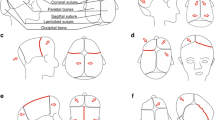Abstract
Crouzon craniofacial dysostosis (CFD) is an autosomal dominant form of craniosynostosis characterized by an abnormal skull shape, with hypertelorism, prominent eyes and midfacial retrusion. Recently, a gene for CFD has been mapped to chromosome 10q25-q26 and mutations in exon B of the fibroblast growth factor receptor 2 (FGFR2) gene have been identified. Here, we report the mapping of a CFD gene to chromosome 10q by close linkage to probe AFMa197wbl at locus D10 S1483 in six unrelated families of French ancestry (Z max = 4.69 at θ = 0) and provide additional evidence of genetic homogeneity of this condition. In addition, we report a novel mutation in exon B of the FGFR2 gene (Cys 342 Trp) in familial CFD and describe recurrent mutations at codon 342 as a particularly frequent event in CFD. Since mutations in the extracellular domain of the FGFR2 gene are observed in a few clinically distinct craniosynostosis syndromes (CFD, Jackson-Weiss, Apert and Pfeiffer), the present study gives support to the variable clinical expression of FGFR2 mutations in humans.
Similar content being viewed by others
References
Cohen MM Jr (1986) Syndromes with craniosynostosis. In: Cohen MM Jr (ed) Craniosynostosis. Diagnosis, evaluation, and management. Raven Press, New York, pp 413–590
Crouzon O (1912) Dysostose cranio-faciale héréditaire. Bull Soc Med Hôp Paris 33:545–555
Gorlin RJ, Cohen MM Jr, Levin LS (1990) Syndromes of the head and neck, 3rd edn. McGraw-Hill, New York, pp 524–626
Jabs EW, Li X, Scott AF, Meyers G, Chen W, Eccles M, Mao J, Charnas LR, Jackson CE, Jayle M (1994) Jackson-Weiss and Crouzon syndromes are allelic with mutations in fibroblast growth factor receptor 2. Nature Genet 8:275–279
Lajeunie E, Ma HW, Bonaventure J, Munnich A, Le Merrer M, Renier D (1995) FGFR2 mutations in Pfeiffer syndrome. Nature Genet 9:108
Li X, Lewanda AF, Eluma F, Jerald H, Choi H, Alozie I, Proukakis C, Talbot CC, Kolk CV, Bird LM, Jones MC, Cunningham M, Clarren SK, Pyeritz RE, Weissenbach J, Jackson CE, Jabs EW (1994) Two craniosynostotic syndrome loci, Crouzon and Jackson-Weiss, map to chromosome 10q23–26. Genomics 22:418–424
Marchac D, Renier D (1995) Congenital craniofacial malformations. In: Youmans JR (ed) Neurological surgery, 4th edn. Saunders, Philadelphia (in press)
Muenke M, Schell U, Hehr A, Robin NH, Losken HW, Schinzel A, Pulleyn LJ, Rutland P, Reardon W, Malcom S, Winter RM (1994) A common mutation in the fibroblast growth factor receptor 1 gene in Pfeiffer syndrome. Nature Genet 8:269–274
Preston RA, Post JC, Keats BJB, Aston CE, Ferrell RE, Priest J, Nouri N, Losken W, Morris CA, Hurtt MR, Mulvihill JJ, Ehrlich GD (1994) A gene for Crouzon craniofacial dysostosis maps to the long arm of chromosome 10. Nature Genet 7:149–153
Reardon W, Winter RM, Rutland P, Pulleyn LJ, Jones B, Malcolm S (1994) Mutations in the fibroblast growth factor receptor 2 gene cause Crouzon syndrome. Nature Genet 8:98–102
Rousseau F, Bonaventure J, Legeai-Mallet L, Pelet A, Rozet JM, Maroteaux P, Le Merrer M, Munnich A (1994) Mutations in the gene encoding fibroblast growth factor receptor-3 in achondroplasia. Nature 371:252–254
Shiang R, Thompson LM, Zhu YZ, Church DM, Fielder TJ, Bocian M, Winokur ST, Wasmuth JJ (1994) Mutations in the transmembrane domain of FGFR3 cause the most common genetic form of dwarfism, achondroplasia. Cell 78:335–342
Wilkie A, Slaney S, Oldridge M, Poole ND, Ashworth GJ, Hockley AD, Hayward RD, David DJ, Pulleyn LJ, Rutland P, Malcom S, Winter RM, Reardon W (1995) Apert syndrome results from localized mutations of FGFR2 and is allelic with Crouzon syndrome. Nature Genet 9:165–171
Author information
Authors and Affiliations
Rights and permissions
About this article
Cite this article
Ma, H.W., Lajeunie, E., Le Merrer, M. et al. No evidence of genetic heterogeneity in Crouzon craniofacial dysostosis. Hum Genet 96, 731–735 (1995). https://doi.org/10.1007/BF00210308
Received:
Revised:
Issue Date:
DOI: https://doi.org/10.1007/BF00210308




